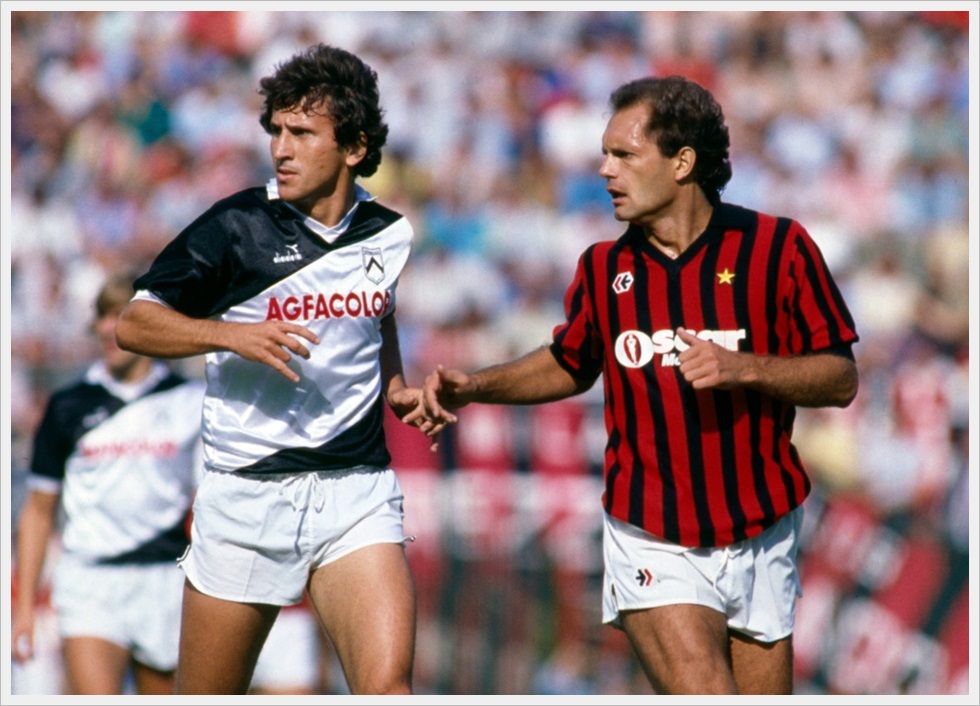Zico, or Arthur Antunes Coimbra, was born on 3 March 1953 in Rio. He became known throughout the footballing world as the “White Pelé” for his exploits with Brazil in the 1970’s and 1980’s. Gifted with excellent technical ability and vision, he excelled in the Brazil side of that era, alongside superstars like Socrates and Falcao. He is still revered around the world today for his ability to score spectacular free kicks before it became ‘hip’.
But did you know he graced Serie A for two years in the mid-1980s? Zico was a wanted man in Europe, especially in Italy where household names such as AS Roma and AC Milan were competing for his coveted signature. Thus, it came as somewhat of a surprise when he signed for the relatively unknown Udinese in the summer of 1983.
Zico arrived in Udine as an established name, having played over 200 games for Brazilian side Flamengo. It was a major signing for the Bianconeri and remains one of the biggest in their history, both for the transfer and the coverage that followed. Headlines were written before the Brazilian even arrived in Italy, as the debate over the legality of his transfer and his fee were brought into the public domain.
Despite the controversy, the prospect of capturing a Brazilian superstar brought a buzz to Udine and their supporters. When the transfer was finally completed and Zico signed on the dotted line, the club saw over 26,000 new season tickets purchased over the summer. The deal was done and the Friulian’s could finally dream of success with Zico as their talisman.
During his first season in Serie A, Zico delivered exactly what he had promised. He played flamboyantly, captivating the supporters of his new club. His partnership with World Cup winner, Franco Causio, threatened to take Udinese to the next level yet the team failed to truly deliver. Despite Zico’s excellent performances, the Bianconeri’s season ended in disappointment as they could only manage a ninth place finish in Serie A.
Zico scored 19 goals that season, one fewer than top scorer Michael Platini of Juventus and his performances saw him voted as the 1983 ‘Player of the Year’ by World Soccer Magazine. Zico had taken to playing for the Zebrette (little Zebra’s) and the supporters had immediately adopted him as one of their own.
The following season consisted of injuries and suspensions for Zico, the latter for openly attacking referees. His frustration also boiled over off the pitch and he openly criticised the Udinese board for their lack of ambition. In his eyes the owners were parsimonious, reluctant to sign high quality players which made the team overly reliant on Zico’s performances.
On May 12, 1985, thousands of fans flocked to the Stadio Friulli with a sense of anticipation. Udinese’s final home game of the 1984/85 season brought with it inevitable attention for two reasons. One because the game had been billed as the ultimate showdown between arch-rivals Brazil and Argentina, Zico’s Udinese versus Diego Maradona’s Napoli. And two because it was Zico’s last match in the black and white of Udinese before he returned to Brazil and his beloved Flamengo.
Fans were hopeful of a spectacle from the duo, who at the time, were two of the best no.10’s in the world. While the 32-year-old Zico was about to depart Serie A, the 24-year-old Maradona was in his debut season at Napoli. The diminutive maestros did not disappoint. Maradona opened the scoring after just four minutes with a free kick from 20-plus yards out. Not to be outdone, Zico responded for the home side almost immediately with one of his trademark free kicks – the ball was eventually turned home in the resulting pinball scramble to make it 1-1.
The game was living up to its billing, the Zico vs. Maradona show, just as many had hoped. Zico was desperate for a final victory, a departing present to leave the Friuli faithful. In the second-half the, the Brazilian lined up another free kick but instead of shooting, he rolled the ball to Luigi De Agostini who smashed the ball past a the flummoxed Napoli keeper, Luciano Castellini.
But controversy lay just around the corner. With the clock ticking down towards a Zico-inspired win for Udinese, Maradona produced the most memorable moment in the match and one that proved to be a dress rehearsal for one of the most infamous in footballing history…the Hand of God.
In the 88th minute, Maradona appeared to out-jump the Udinese goalkeeper to head home the equaliser after the ball had rebounded off the crossbar. The protests were instantaneous. The replays confirmed that the Argentinian had used his hand to guide the ball into the net. Maradona’s instant reaction, running and jumping for joy in celebration, caused doubts of any wrongdoing prompting Zico to allegedly confront him saying: “If you’re an honest man, confess to the referee that you used your hand!”
The match finished 2-2 and the fallout was instantaneous. Zico was furious and after protesting with the referee, Giancarlo Pirandola, after the game he went onto to say: “I have seen wrong things like that in football before. Against Napoli [we] deserved to win , however in the last minute the referee allowed Maradona to equalise with a goal spoiled by handball.”
To add to Zico’s disappointment and woes, he was also having legal problems during his time in Italy. He was charged with tax evasion, which included a hefty fine and jail time. Unsurprisingly instead of serving his prison sentence, Zico decided to leave Italy and return to Brazil.
It was a sour end to a magical stay on the peninsula. However, to this day Udinese fans still fly Zico banners as a tribute to one of the most beloved Little Zebra’s in the clubs history.

